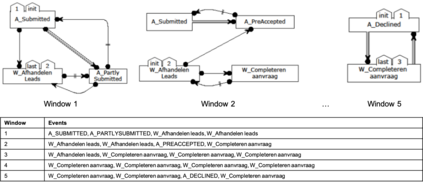The field of predictive process monitoring focuses on modelling future characteristics of running business process instances, typically by either predicting the outcome of particular objectives (e.g. completion (time), cost), or next-in-sequence prediction (e.g. what is the next activity to execute). This paper introduces Processes-As-Movies (PAM), a technique that provides a middle ground between these predictive monitoring. It does so by capturing declarative process constraints between activities in various windows of a process execution trace, which represent a declarative process model at subsequent stages of execution. This high-dimensional representation of a process model allows the application of predictive modelling on how such constraints appear and vanish throughout a process' execution. Various recurrent neural network topologies tailored to high-dimensional input are used to model the process model evolution with windows as time steps, including encoder-decoder long short-term memory networks, and convolutional long short-term memory networks. Results show that these topologies are very effective in terms of accuracy and precision to predict a process model's future state, which allows process owners to simultaneously verify what linear temporal logic rules hold in a predicted process window (objective-based), and verify what future execution traces are allowed by all the constraints together (trace-based).
翻译:预测过程监测领域的重点是模拟运行业务流程实例的未来特征,通常通过预测特定目标的结果(如完成(时间),成本)或后继预测(如下一项活动将执行何种活动)来预测特定目标的结果(如完成(时间),成本)或后继预测(如下一项活动将执行何种活动),从而模拟运行业务流程实例的未来特征。本文件介绍了程序-As-Movies(PAM),这是一种在预测性监测之间提供中间点的技术,通过捕捉过程执行跟踪各个窗口中的活动之间的声明过程限制,这是随后执行阶段的一个声明性过程模型。一个过程模型的高维度表示可以应用预测性模型,说明这些制约因素在整个过程执行过程中会如何出现和消失。各种针对高维投入的经常性神经网络结构被用于模拟过程模型的演变,其窗口是时间步骤,包括编码-分解器长期记忆网络,以及革命性短期记忆网络。结果显示,这些表面现象在预测过程模型未来状态方面非常有效,使流程所有人能够同时核查这些制约因素的出现和消失时间规则。







